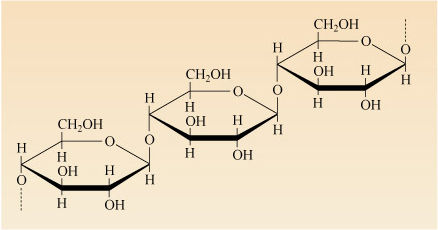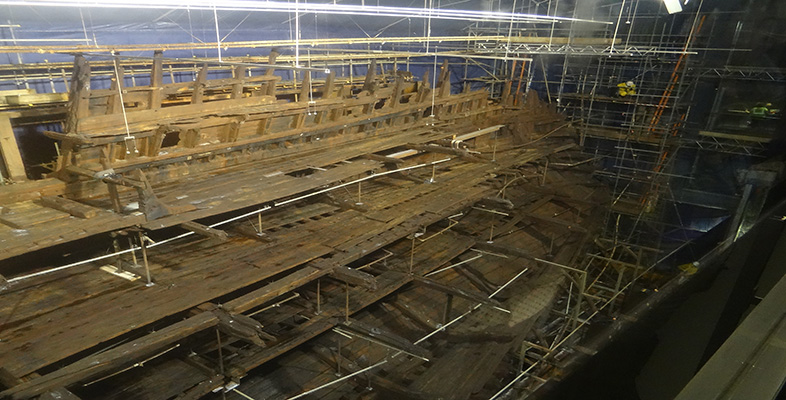5 Preserving the Mary Rose
For over 400 years the Mary Rose lay on the seabed. During that time, her timbers became waterlogged and weakened and were attacked by bacteria and marine organisms. It was important to understand the preservation state of these timbers both before and after salvage, to ensure the Mary Rose could be conserved for future generations to enjoy and study.
Wood is composed of cellulose, a complex macromolecule consisting of chains of glucose molecules linked together by oxygen atoms (Figure 7). The chains of glucose molecules are held tightly together by hydrogen bonding, resulting in a tough, fibre-like structure. In chemical terms, cellulose is a polysaccharide. (Polysaccharides are complex sugar molecules composed of repeating units of monosaccharides such as glucose.) Figure 7 shows three glucose units linked together. In reality, many thousands of glucose units are present in each chain, and a large number of these straight chains are packed very tightly together.

There are also other components to wood: hemicellulose (another polysaccharide made up of branching chains of glucose, xylose and other sugar molecules) and lignin (a complex molecule that binds the cellulose and hemicellulose together). When wood is waterlogged, the water seeps into the structure of the cellulose, and binds to the glucose molecules by hydrogen bonding, causing the wood to swell. This weakens the structure of the wood.
Cellulose and hemicellulose are easily attacked by aerobic biological organisms (i.e. those that thrive in oxygenated conditions). These organisms use the sugar molecules for respiration (according to the reaction described in the chemical equation below) generating carbon dioxide and water as products:

Weak swollen wood is especially attractive to biological organisms.
On salvage, the Mary Rose's timbers began to dehydrate when the water trapped in the wood's structure evaporated, causing the wood to shrink and crack, and the cellulose structure to collapse. If left to proceed, this would ultimately lead to a complete loss of the timbers' structural integrity and disintegration of the ship. Therefore, it was necessary to maintain the waterlogged conditions in order to preserve the ship intact. On salvage, a system of cold water spraying was developed that would allow the wood's structural integrity to be sustained across the whole hull. The ship was also kept in a huge refrigerated room where the temperature was maintained between 2 and 5 °C and under low-level lighting.
Analysts ascertained the extent and type of decay taking place in the timbers in order to prevent further deterioration. They did not analyse entire timbers, although most needed to be sampled using the least disruptive methods possible.
Why would it be necessary to sample several timbers if they had all experienced similar burial and preservation histories?
The timbers may be made from different types of wood, which may have differing susceptibilities to decay. Recall that the Mary Rose was refitted twice with new timbers, so they may also have been of different ages, or used in different locations on the ship.
The use of timbers of different ages and at different locations also meant that there was potential for varying degrees of degradation.
What steps could be taken to ensure that subsequent analyses were representative of the ship as a whole, despite sampling constraints?
In any analysis, it is important to repeat the analysis on another portion of the same sample to ensure the results are accurate.
